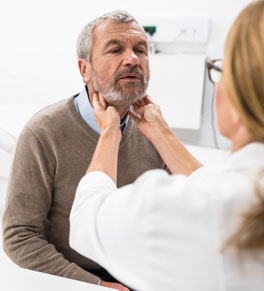HPV linked to epidemic of throat cancer

There is an emerging U.S. epidemic of throat cancers and recent research has identified the human papilloma virus, or HPV, as the likely cause.
HPV is the same virus that is responsible for most cases of cervical cancer. But while early detection and vaccination has led to a decrease in cervical cancer in women, HPV-associated cancers of the tonsils and back of the tongue or throat have been increasing exponentially in men over the last two decades.
Throat cancer affects men 4 to 1
“It’s showing up in men four times as often as in women,” says UCI Health throat specialist Dr. Tjoson Tjoa, assistant professor of otolaryngology at UCI School of Medicine. “It’s occurring primarily in educated white men in the United States and other developed nations, and at much younger ages than we saw previously.”
In the past, oropharyngeal cancers were typically found in men in their 70s and 80s who’d smoked and drank heavily throughout their lives. From 1988 to 2004, however, a three-fold increase in cases in younger men without a history of longtime smoking or drinking pointed to a burgeoning epidemic.
An estimated 53,000 (38,000 men and 14,800 women) new U.S. cases of oral and oropharyngeal cancer are expected to occur in 2020. The Centers for Disease Control & Prevention (CDC) estimates that about 70% of them will be linked to HPV.
This already surpasses the incidence of cervical cancer – an estimated 13,000 new cases in U.S. women in 2020 – which has declined by 50% between 1975 and 2015, due mainly to screening and early detection.
Cancer can appear decades after exposure
So why is this happening?
“Oral sex is the cause, and in recent years this practice has become more prevalent in developed areas of the world,” Tjoa explains. “HPV is the most common sexually transmitted disease, so much so that nearly all sexually active men and women are exposed to it.”
Most people may get a throat infection from the virus that goes away, but some people may go on to develop cancer in the throat or tonsils some 20 to 30 years later. When a vaccine against HPV was introduced in the United States in 2006, the CDC recommended it for children beginning at ages 11 or 12, or before they become sexually active. The vaccination campaigns were aimed mainly at girls and women to prevent cervical cancer.
But Tjoa says not enough people made the connection between HPV and throat cancers that were appearing in men and women 20 or 30 years after exposure.
HPV-related cancers: completely preventable
“That’s unfortunate, since it’s potentially completely preventable with good vaccination,” says Tjoa. “If 100% of boys were vaccinated before they became sexually active, we wouldn’t have this disease.”
Vaccination, he says, is the only thing that decreases the risk. Vaccines are now approved by the CDC for males and females between the ages of 10 ½ and 45. Does it work for people who’ve already been exposed? Tjoa doesn’t think so but he adds that vaccinations can’t hurt: “It’s better to be safe than sorry.”
The vaccine comes in a number of different strains, all cover HPV16, the one that causes the cancers in 95% of the HPV-related cancers.
Very treatable cancers
These types of cancers aren’t usually found early for a number of reasons. One, there’s a latency factor. Two, they tend to be slow growing. And three, they’re not easy to see like a spot on the hand that may be an indication of skin cancer.
By the time oral or oropharyngeal cancer is recognized — typically when a patient notices a lump on the back of the neck — it already has spread to the lymph nodes in the neck.
Even so, Tjoa wants men to know that if their cancer is determined to be related to HPV, surgery, radiation and chemotherapy can be very effective.
For the past two years, he and his fellow UCI Health otolaryngologists have been removing the cancers with minimally invasive, robot-assisted surgical techniques. They perform three to four of these surgeries each month, he says.
Many oral and oropharyngeal cancers are also treated successfully with radiation and chemotherapy, he says.
Signs and symptoms
The important thing is to catch it as early as possible, Tjoa says. The most common signs of oral and oropharyngeal cancers are:
- A mouth or lip sore that doesn’t heal
- A red or white patch on the gums, tongue, tonsil or mouth lining
- A lump on the lip, mouth, neck or throat
- A thickening in the cheek
- A persistent sore throat or feeling that something is caught in the throat
- A hoarseness or change in voice
- A numbness of mouth or tongue
- Pain or bleeding in the mouth
- Difficulty chewing or swallowing
- Pain in the jaw or ear
- Chronic bad breath
If you are experiencing any of these symptoms, Tjoa says it’s important to see a doctor immediately. And if HPV-related oral cancer is diagnosed, he adds, “Our minimally invasive surgical method allows us to treat them effectively.”




